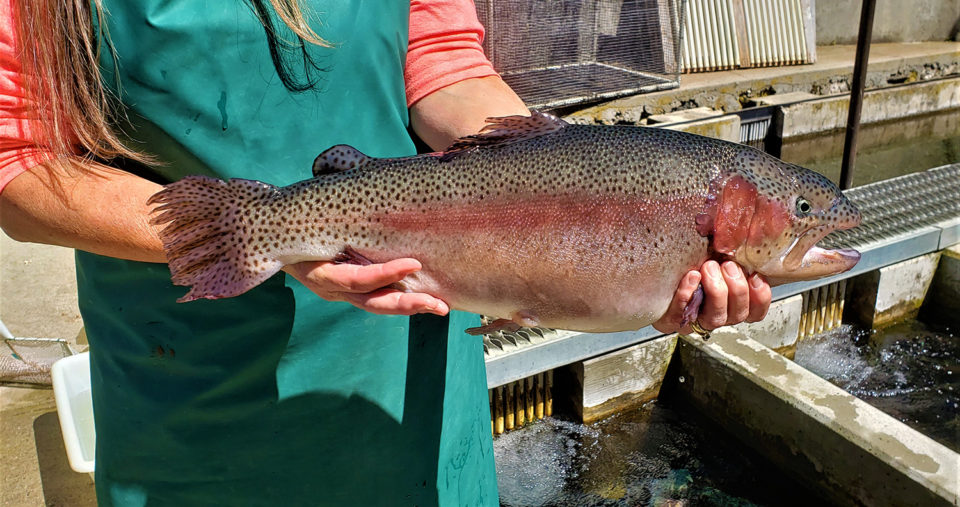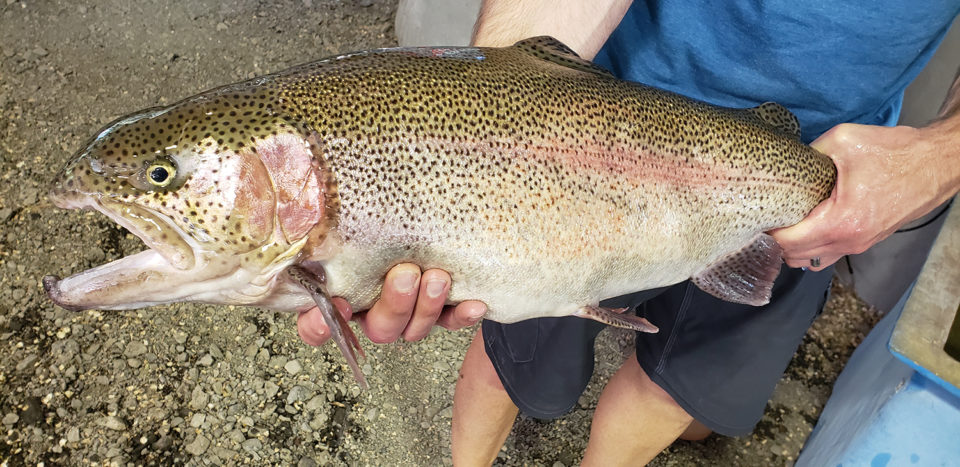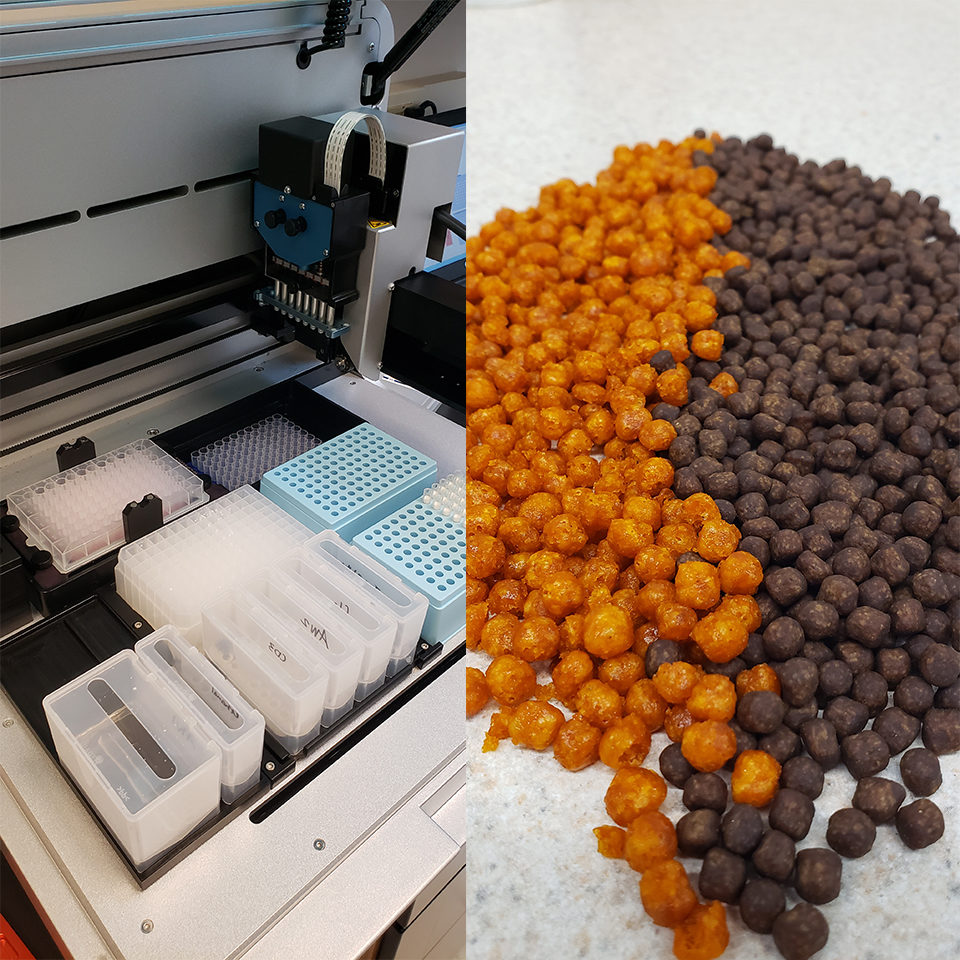USDA-ARS researchers develop strain of rainbow trout that performs well on a soybean-based diet

Rainbow trout are a carnivorous species, but vegetarian versions could soon be the cultured fish of choice after genetic selection research has resulted in a line of fish that can be raised on a cost-effective and fully plant-based diet.
The United States Department of Agriculture’s Agricultural Research Service (USDA-ARS) says that nine generations of rainbow trout (Oncorhynchus mykiss) have been farmed since its research began 19 years ago.
USDA-ARS research geneticist Dr. Ken Overturf is based in Southern Idaho, where 70 percent of commercial U.S. trout production occurs. Overturf and his team developed an all-plant protein soybean-based diet to be used during selection before genetically introgressing several trout strains, feeding them the feed and evaluating their growth rate, feed conversion ratio (FCR), morphology, mortality and enteritis development.
In each generation, the team found positive results, including better growth and less enteritis. During the fifth generation, the stringency of the diet was raised when soybean meal levels were increased from 15 to 20 percent. After the seventh generation, this was brought up to 25 percent.
“Now, at five months, the fish are over 400 grams on the most stringent diet,” said Overturf.
Nutritional studies with the selected strain has determined that these fish have improved synchronous uptake and processing of amino acids and proteins which translates into better protein retention and reduced feed conversion ratios. Furthermore, reduced variation in microbiome populations was noted for the selected strain compared to control strains when fed either fishmeal or plant-based feeds.
The importance of fish oil
The dietary replacement of fishmeal and fish oil is not unknown in rainbow trout aquaculture. Recently, researchers at the University of Tehran found that trout given essential oils from thyme demonstrated better specific growth rates and weight gain, as well as higher levels of the protein complement component 3 (C3) that plays a vital role in the immune system. But plant-based diets still require further research.
“One major nutritional obstacle for aquaculture feeds and something that we are trying to address now is that fish oil is an even rarer and more expensive commodity than fishmeal,” said Overturf. “Fish oil is what provides healthy omega-3 fatty acids that are good for heart and brain function, but these aren’t present in plant oils. Now that we have a strain of rainbow trout that grows exceedingly well on plant proteins, we’re replacing fish oil with specific plant oils and have started selecting for fish that biosynthesize and convert these plant oils to DHA (docosahexaenoic acid) and EPA (eicosapentaenoic acid) and deposit this in muscle tissue.”
Results from two generations of selection have been promising, he said.
“The development of a strain of fish that can completely consume a sustainable diet containing no fishmeal or fish oil, grows rapidly without any deleterious health effects and still provides all the healthy benefits to consumers is of great interest to commercial producers. We’re now looking to evaluate and select such fish under more varied environmental conditions.”

Fewer fish from the sea
Aquafeed production has traditionally required extracting forage fish from the sea, for fishmeal and fish oil, but as the global appetite for seafood rises, so too does the pressure to produce more fishmeal. To avert ecological harm and defray rising costs, more fish farmers are reducing fishmeal levels in feed. Although alternatives like plants are promising substitutes or complements to traditional feed formulations, carnivorous species are typically ill-suitedto subsisting on vegetable matter.
But Rick Barrows, a former fish nutritionist who worked at the U.S. Department of Agriculture, says that having a diversity of feed ingredients, including plant-based options, is key for aquaculture.
“The recent development of plant-based feeds for rainbow trout identified the nutrients that the species required,” he said. “That provides more versatility in what kind of ingredients could be included in aquaculture feeds. We could see a growing trend toward increasing the number of ingredients in diets and more flexibility to change diets as the price of ingredients changes. This is done all the time in terrestrial animal feed. Aquaculture feed isn’t as flexible due to the number of ingredients and the knowledge based around those ingredients isn’t as well developed.”
“Plant proteins show great promise,” said Overturf. “It’s also worth noting that they are produced at much greater levels than fishmeal – think of fishmeal at 4 [million metric tons] and soybean at 660 [million metric tons] and then add in corn, rice or wheat. With higher volumes the price can be kept lower and won’t shift as much as it does for rarer commodities.
“However, when it comes to rainbow trout, there are differences in how plant-based feeds affect them, depending on the protein source and level of incorporation,” he continued. “Some different protein sources are fine when included in the diet at certain lower levels but can become problematic as you either increase the levels or feed to the fish for an extended period of time.”

A growing number of options
Fishmeal alternatives continue to be developed, like algae, bacteria from methane production or microbial proteins from carbon dioxide sequestration. Barrows said that the trick is to make plant meal behave like fishmeal, not to turn carnivores into herbivores.
“We’re trying to turn plant-based ingredients into animal-based ingredients,” he said. “Fish don’t require fishmeal. They require the nutrients that fishmeal happens to contain. That’s why fishmeal has been used so much in aquaculture. If you take the fishmeal out, you must supplement with other ingredients to get the necessary nutrients, hence the need to develop other protein sources.
“If diets are formulated correctly and contain all essential nutrients, growth rate and feed efficiency will be good,” he continued. “It was possible to eliminate fishmeal from rainbow trout diets and maintain good growth and health by determining the nutrients in fishmeal that rainbow trout need and including those in alternative diets.”
Follow the Advocate on Twitter @GAA_Advocate
Now that you've finished reading the article ...
… we hope you’ll consider supporting our mission to document the evolution of the global aquaculture industry and share our vast network of contributors’ expansive knowledge every week.
By becoming a Global Seafood Alliance member, you’re ensuring that all of the pre-competitive work we do through member benefits, resources and events can continue. Individual membership costs just $50 a year. GSA individual and corporate members receive complimentary access to a series of GOAL virtual events beginning in April. Join now.
Not a GSA member? Join us.
Author
-

Bonnie Waycott
Bonnie Waycott is a freelance writer specializing in aquaculture development and fisheries management, with a particular focus on Japan. She has a keen interest in the recovery of aquaculture in Tohoku, following the Great East Japan Earthquake and Tsunami of March 2011.
Tagged With
Related Posts

Innovation & Investment
Aquafeed opportunity attracts pioneers from fields afar
As business leaders switch focus from biofuels and energy to food security, one convert dubs the aquafeed opportunity a needed “redeployment” of knowledge.

Intelligence
Wanted: More omega-3s. But from where?
Cargill and Australia’s Nuseed are both investing large sums of money in the development of a genetically modified canola oil rich in DHA. Meanwhile, a leading nutritionist casts doubts on the necessity of omega-3s from fish.

Aquafeeds
A push for rapeseed as a viable aquafeed ingredient
One Germany-based company says rapeseed protein concentrate, or RPC, can help aquafeed manufacturers meet growing demand.

Aquafeeds
Aquaculture Exchange: Rick Barrows
After 14 years with the USDA’s Agricultural Research Service, Rick Barrows talks about the importance of finding ‘complete’ and commercially viable alternative sources of omega-3 fatty acids and continuing innovation in the aquafeed sector.

